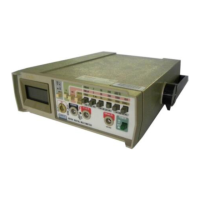If you do not know approximately
what the current is, connect
the circuit to
the
A inputterminalfirsttoseeifyouhaveasafe
level
for
the
mA/jA input terminal. Use
the
mAM
input
terminal for current up
to
400 mA.
When measuring
current,
the
meter's internal
shunt resistors
develop a
voltage across the meter's terminals called "burden
voltage." This voltage
drop is very low in your
meter,
but
it
may
affect precision
circuits or measurements.
To calculate the
burden voltage: in A,
multiply the display
reading
by
0.03V; in
mA, multiply
the
display
reading
by
1.5 mV;
\r\fiA,
multiply
the
display reading by "IOOaiV.
For example, at a
20 mA display reading,
the
burden voltage
is 20.00 x 1.5 mV
=
30
mV.
The
approximate resistance between the
input terminals is
0.03 ohms for
A, 1.5 ohms for
mA,
and
100
ohms for/yA.
Continuity
Testing
Continuity testing
verifies that
circuit connections
are
intact.
To
perform
audibl
e
con
tinuity tests, set
the
rotary switch to
mil
n press the
(
-mi
)
button,
and connect the
meter to your
circuit. Test resistances
below the values
listed in Table 2
cause
the
meter
to
emit
a
continuous
tone. Use the 400
ohm
range for most
wiring
checks.
APPLICATIONS
Measuring
Current
The
continuity mode is extremely fast and can be used
to
detect either
shorts
or
opens
that last
for
as
little
as
1 milli-
second.
When
a
change is detected,
the
beeper tone is
"stretched" to last
at
least
V* second so you can
hear it
and
detect both shorts and
opens. This can be
a
valuable trouble-
shooting aid
when
looking
for
intermittents associated with
cables, connections, switches,
relays, etc. If the test value is
very
close to the
th
reshol
d
,
erratic
beeps ca n
a
Iso occur d
ue
to
environmental electrical noise (EMI).
Measuring Resistance
CAUTION
Turn off power on
the
test
circuit and discharge
all
capacitors before
attempting in-circuit resist-
ance
measurements. If
an external voltage is
present across
a
component, it will be
impossible
to
take an
accurate
measurement
of
the resist-
ance
of
that component.
The meter measures
resistance by
passing a
known current
through the external
circuit or component, measuring
the
vol-
tage
drop, and calculating the resistance using Ohm's Law
(0=V/A). Remember, the
resistance displayed by
the meter
is
the
total resistance through all possible
paths between
the
probes. This explains
why in-circuit measurement of resistors
does
not often
yield the ohms value indicated by the
resistor's
color code.
19

